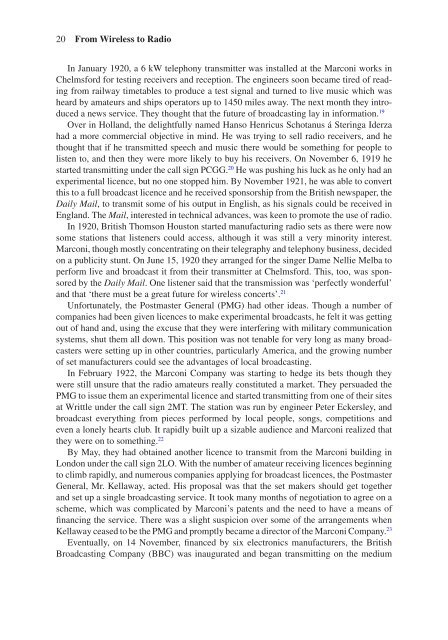The Electronics Revolution Inventing the Future
Create successful ePaper yourself
Turn your PDF publications into a flip-book with our unique Google optimized e-Paper software.
20 From Wireless to Radio<br />
In January 1920, a 6 kW telephony transmitter was installed at <strong>the</strong> Marconi works in<br />
Chelmsford for testing receivers and reception. <strong>The</strong> engineers soon became tired of reading<br />
from railway timetables to produce a test signal and turned to live music which was<br />
heard by amateurs and ships operators up to 1450 miles away. <strong>The</strong> next month <strong>the</strong>y introduced<br />
a news service. <strong>The</strong>y thought that <strong>the</strong> future of broadcasting lay in information. 19<br />
Over in Holland, <strong>the</strong> delightfully named Hanso Henricus Schotanus á Steringa Iderza<br />
had a more commercial objective in mind. He was trying to sell radio receivers, and he<br />
thought that if he transmitted speech and music <strong>the</strong>re would be something for people to<br />
listen to, and <strong>the</strong>n <strong>the</strong>y were more likely to buy his receivers. On November 6, 1919 he<br />
started transmitting under <strong>the</strong> call sign PCGG. 20 He was pushing his luck as he only had an<br />
experimental licence, but no one stopped him. By November 1921, he was able to convert<br />
this to a full broadcast licence and he received sponsorship from <strong>the</strong> British newspaper, <strong>the</strong><br />
Daily Mail, to transmit some of his output in English, as his signals could be received in<br />
England. <strong>The</strong> Mail, interested in technical advances, was keen to promote <strong>the</strong> use of radio.<br />
In 1920, British Thomson Houston started manufacturing radio sets as <strong>the</strong>re were now<br />
some stations that listeners could access, although it was still a very minority interest.<br />
Marconi, though mostly concentrating on <strong>the</strong>ir telegraphy and telephony business, decided<br />
on a publicity stunt. On June 15, 1920 <strong>the</strong>y arranged for <strong>the</strong> singer Dame Nellie Melba to<br />
perform live and broadcast it from <strong>the</strong>ir transmitter at Chelmsford. This, too, was sponsored<br />
by <strong>the</strong> Daily Mail. One listener said that <strong>the</strong> transmission was ‘perfectly wonderful’<br />
and that ‘<strong>the</strong>re must be a great future for wireless concerts’. 21<br />
Unfortunately, <strong>the</strong> Postmaster General (PMG) had o<strong>the</strong>r ideas. Though a number of<br />
companies had been given licences to make experimental broadcasts, he felt it was getting<br />
out of hand and, using <strong>the</strong> excuse that <strong>the</strong>y were interfering with military communication<br />
systems, shut <strong>the</strong>m all down. This position was not tenable for very long as many broadcasters<br />
were setting up in o<strong>the</strong>r countries, particularly America, and <strong>the</strong> growing number<br />
of set manufacturers could see <strong>the</strong> advantages of local broadcasting.<br />
In February 1922, <strong>the</strong> Marconi Company was starting to hedge its bets though <strong>the</strong>y<br />
were still unsure that <strong>the</strong> radio amateurs really constituted a market. <strong>The</strong>y persuaded <strong>the</strong><br />
PMG to issue <strong>the</strong>m an experimental licence and started transmitting from one of <strong>the</strong>ir sites<br />
at Writtle under <strong>the</strong> call sign 2MT. <strong>The</strong> station was run by engineer Peter Eckersley, and<br />
broadcast everything from pieces performed by local people, songs, competitions and<br />
even a lonely hearts club. It rapidly built up a sizable audience and Marconi realized that<br />
<strong>the</strong>y were on to something. 22<br />
By May, <strong>the</strong>y had obtained ano<strong>the</strong>r licence to transmit from <strong>the</strong> Marconi building in<br />
London under <strong>the</strong> call sign 2LO. With <strong>the</strong> number of amateur receiving licences beginning<br />
to climb rapidly, and numerous companies applying for broadcast licences, <strong>the</strong> Postmaster<br />
General, Mr. Kellaway, acted. His proposal was that <strong>the</strong> set makers should get toge<strong>the</strong>r<br />
and set up a single broadcasting service. It took many months of negotiation to agree on a<br />
scheme, which was complicated by Marconi’s patents and <strong>the</strong> need to have a means of<br />
financing <strong>the</strong> service. <strong>The</strong>re was a slight suspicion over some of <strong>the</strong> arrangements when<br />
Kellaway ceased to be <strong>the</strong> PMG and promptly became a director of <strong>the</strong> Marconi Company. 23<br />
Eventually, on 14 November, financed by six electronics manufacturers, <strong>the</strong> British<br />
Broadcasting Company (BBC) was inaugurated and began transmitting on <strong>the</strong> medium


















